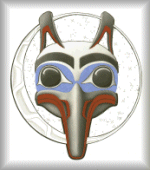 "Art of Alaska and the Pacific Northwest Coast"
"Art of Alaska and the Pacific Northwest Coast"
"Techniques of the Artist"
For many years now my ideas for drawings have been focused on northwest coast totemic art. It's a very dynamic, well-balanced, and design oriented form that works well with pen and ink. It is also so much more than merely the art form of the northwest coast nations. It reflects their culture, their history, and their heritage. I realize the importance of this and try to research my pieces thoroughly in order to portray these cultures with the respect they deserve. I strive for my work to be uniquely contemporary and yet traditional, basing my compositions on age-old principles while innovating with new ideas. It's become quite alot of fun.
If you are looking for any continuity in my work as a whole, you'll find it primarily in the way I use the medium. I am willing to spend several hundred hours on a single piece. I believe that enables me to get effects from pen and ink that make my work unique. I will never be prolific, but the quality of my work will stand on its own.
Probably my favorite technique is pointillism which I take to extremes. Although very time consuming it is suprisingly versatile. It allows me to create textures and detail in a wide range and lighting that can be striking in contrast or quite subtle.
Black and white is my focus. It is elegant, clean, and honest. It forces me into stronger and truer compositions. Now, I have nothing against color and use it when the spirit of the drawing requires it, but when I want to get to the heart of a matter-I put it in "black and white".
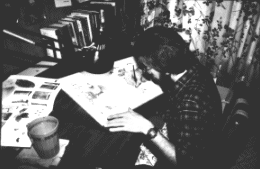
Many people think of pen and ink as a very rigid and hard-edged medium. I find that to be totally untrue. While it can be pretty unforgiving once you've made a mistake, with lots of patience you can create an image whose range of effects is unsurpassed.
I prefer to use a steel-tipped quill pen (crow quill) for most of the line work. I find that it gives me the finest lines and will taper them off as well. A cold-press ragboard has just the right surface texture so that you can skip the point lightly across the upper fibers giving you an incredibly soft and fine line. More and more I am using 4X0 and 6X0 technical pens for the pointillism. They're easier to use for this technique and one heck of a lot cheaper than quill points. (I've used over 2 gross of quill points on one drawing before!)
One of the drawbacks of working with ink can be its permanence-it usually forces you to draw things in the foreground first and then fill in around them (unlike say-acrylics- where you can paint an object right on top of the background). This permanence also forces you to plan out your compositions more thoroughly for there is not much that can be changed once you've started. I pretty much have all aspects of a drawing figured out before I put any ink on the board. Because of that, while I am working on that drawing I am free mentally to plan out the next one.
This series of photographs shows the drawing of an earlier piece called "Night Moves" in five stages. It is 5X7, done entirely with pointillism (over 800,000 dots), and took 187 hours of drawing to complete. Please pardon the poor photography.
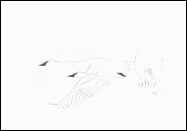
Stage 1- The composition had previously been sketched out in pencil. At this point, the original is begun with both swans being drawn out in pencil and some ink work being done on the bills, eyes and feet.
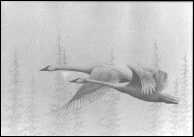
Stage 2- Inking on both swans is complete. The moon and trees have been penciled in lightly to determine their approximate locations. Notes have been made below the bottom margin to indicate those locations. During stages like this I listen to music like Enya or Marc Cohn to keep my nerves settled.
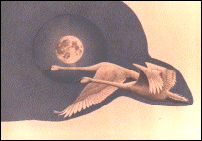
Stage 3- The trees have been erased and the moon has been inked in; work on the sky has now begun. There must be an even transition from light to dark in the moon's halo in order to get the shade I want for the entire background. I have reached that shade of blue and am now beginning to match it in the rest of the sky.
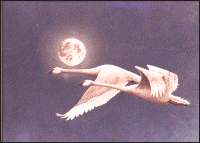
Stage 4- The sky has been completed and the dark shade of blue has been evened out through the entire picture (unfortunately-this is not evident due to the poor quality of the photo but can be noticed in the next one). This was the most tedious phase as there was primarily only one shade to work on. It is also when I listen to Led Zepplin or ZZ Top to push me through those long hours.
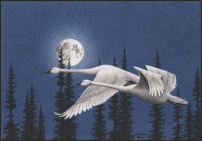
Stage 5- The trees have been added and "Night Moves" is finished! Notice that I decided not to use all of the trees that I had originally planned and that some of their positions vary slightly. This adjustment made for a more balanced composition and helped get this drawing into the finals of the Federal Duck Stamp competition. This photo is a fairly accurate depiction of the original.
(Colored inks can be difficult to work with. They are never as light or color fast as they claim to be and when they touch another color or black, they tend to bleed into each other. In my more recent drawings like Spirit of the Sockeye or Sun of the First Nations, I used acrylic for the crimson color with black ink stippled on top of that for shading. It worked quite well.)
Hopefully this has given you some insight into how my work is done. I hope you enjoy visiting the various galleries here and should you have any comments or questions, please let me know.
Home  Totem Art Gallery
Totem Art Gallery
 Wildlife Art Gallery
Wildlife Art Gallery
Biography
 Art In Progress
Art In Progress
 Techniques
Techniques
 Northwest Stories
Northwest Stories
 Kudos
Kudos
Ordering
 Contact Us
Contact Us
 Links
Links
 Specials
Specials






